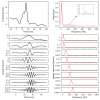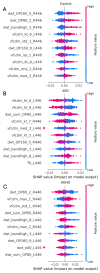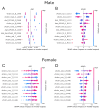Spectral Analysis of Light-Adapted Electroretinograms in Neurodevelopmental Disorders: Classification with Machine Learning
- PMID: 39851292
- PMCID: PMC11761560
- DOI: 10.3390/bioengineering12010015
Spectral Analysis of Light-Adapted Electroretinograms in Neurodevelopmental Disorders: Classification with Machine Learning
Abstract
Electroretinograms (ERGs) show differences between typically developing populations and those with a diagnosis of autism spectrum disorder (ASD) or attention deficit/hyperactivity disorder (ADHD). In a series of ERGs collected in ASD (n = 77), ADHD (n = 43), ASD + ADHD (n = 21), and control (n = 137) groups, this analysis explores the use of machine learning and feature selection techniques to improve the classification between these clinically defined groups. Standard time domain and signal analysis features were evaluated in different machine learning models. For ASD classification, a balanced accuracy (BA) of 0.87 was achieved for male participants. For ADHD, a BA of 0.84 was achieved for female participants. When a three-group model (ASD, ADHD, and control) the BA was lower, at 0.70, and fell further to 0.53 when all groups were included (ASD, ADHD, ASD + ADHD, and control). The findings support a role for the ERG in establishing a broad two-group classification of ASD or ADHD, but the model's performance depends upon sex and is limited when multiple classes are included in machine learning modeling.
Keywords: attention deficit hyperactivity disorder; autism; biomarker; feature selection; medication; retina; sex.
Conflict of interest statement
Aleksei Zhdanov is employed by the company VisioMed.AI which had no role in the design of the study; in the collection, analyses, or interpretation of data; in the writing of the manuscript, or in the decision to publish the results. All other authors declare no conflicts of interest.
Figures











Similar articles
-
Detecting Autism Spectrum Disorder and Attention Deficit Hyperactivity Disorder Using Multimodal Time-Frequency Analysis with Machine Learning Using the Electroretinogram from Two Flash Strengths.J Autism Dev Disord. 2025 Apr;55(4):1365-1378. doi: 10.1007/s10803-024-06290-w. Epub 2024 Feb 23. J Autism Dev Disord. 2025. PMID: 38393437
-
The electroretinogram b-wave amplitude: a differential physiological measure for Attention Deficit Hyperactivity Disorder and Autism Spectrum Disorder.J Neurodev Disord. 2022 May 6;14(1):30. doi: 10.1186/s11689-022-09440-2. J Neurodev Disord. 2022. PMID: 35524181 Free PMC article.
-
Transdiagnostic and sex differences in cognitive profiles of autism spectrum disorder and attention-deficit/hyperactivity disorder.Autism Res. 2022 Jun;15(6):1130-1141. doi: 10.1002/aur.2712. Epub 2022 Mar 28. Autism Res. 2022. PMID: 35347878
-
Machine Learning Methods for Diagnosing Autism Spectrum Disorder and Attention- Deficit/Hyperactivity Disorder Using Functional and Structural MRI: A Survey.Front Neuroinform. 2021 Jan 20;14:575999. doi: 10.3389/fninf.2020.575999. eCollection 2020. Front Neuroinform. 2021. PMID: 33551784 Free PMC article. Review.
-
Meta-Analysis of Sex Differences in Social and Communication Function in Children With Autism Spectrum Disorder and Attention-Deficit/Hyperactivity Disorder.Front Psychiatry. 2019 Nov 4;10:804. doi: 10.3389/fpsyt.2019.00804. eCollection 2019. Front Psychiatry. 2019. PMID: 31749718 Free PMC article.
Cited by
-
The Relationship Between the Ganglion Cell-Inner Plexiform Layer, Retinal Nerve Fiber Layer, and Photopic Negative Response in Newly Diagnosed Pituitary Macroadenoma: 12-Month Prospective Follow-Up Study.Cancers (Basel). 2025 May 1;17(9):1542. doi: 10.3390/cancers17091542. Cancers (Basel). 2025. PMID: 40361469 Free PMC article.
References
-
- Parellada M., Andreu-Bernabeu Á., Burdeus M., San José Cáceres A., Urbiola E., Carpenter L.L., Kraguljac N.V., McDonald W.M., Nemeroff C.B., Rodriguez C.I., et al. In search of biomarkers to guide interventions in autism spectrum disorder: A Systematic Review. Am. J. Psychiatry. 2023;180:23–40. doi: 10.1176/appi.ajp.21100992. - DOI - PMC - PubMed
-
- Schwitzer T., Le Cam S., Cosker E., Vinsard H., Leguay A., Angioi-Duprez K., Laprevote V., Ranta R., Schwan R., Dorr V.L. Retinal electroretinogram features can detect depression state and treatment response in adults: A machine learning approach. J. Affect. Disord. 2022;306:208–214. doi: 10.1016/j.jad.2022.03.025. - DOI - PubMed
LinkOut - more resources
Full Text Sources

